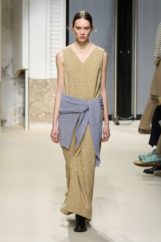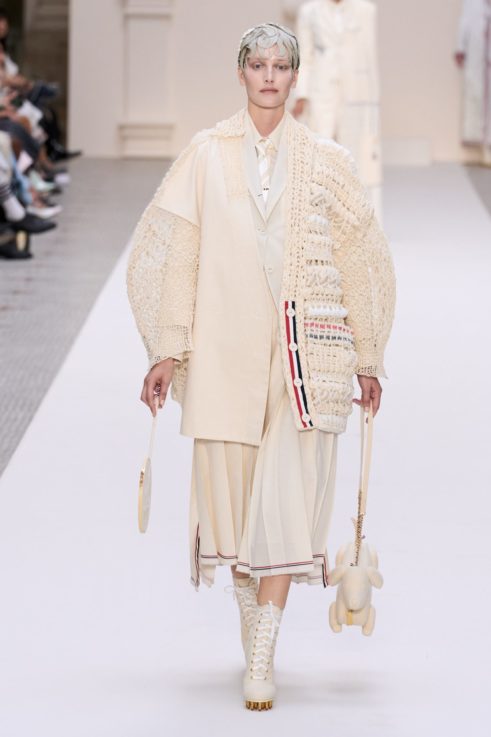Dear Shaded Viewers,
Before the season really gets any further underway; already we’ve had Pitti Uomo, and Milan menswear and now Paris menswear, before heading full pelt into womenswear collections, let’s pause for a moment. I have a thought about what is already very clearly revealed, that drastic change is being ignored in favour of beautiful clothes, that theatrical tricks and extreme productions and OTT exaggerations are generally absent. It doesn’t mean that fashion is not interesting, or even exciting, but it does mean that the chasm between wildly abandoned inventiveness, and a strict eye on the money coming in, is continuing to be of huge interest to any observer of fashion.
There are literally hundreds of reasons why editors, Instagramers, commentators, stylists, bloggers and influencers demand change, and only seem to respond to extravagant fashion, theatrical shows and attention seeking stunts. It is obvious that elaborate makeup and hair, wild mis en scene and loads of ideas, novelties and conceptual stories fill space, provide strong visuals, prompt plenty of opinion pieces, are “of the moment” exciting, but are then quickly forgotten by these same people when the next “exciting” show happens. Instant visual gratification requires less in-depth knowledge, understanding or analysis; simply instant observations like so many who offer their criticism of red-carpet dressing.
Since we are embarking on another season it is fascinating that names like Emporio Armani, Dunhill, Zegna, Dries Van Noten, Lemaire and Auralee show beautiful clothes, sometimes in beautiful locations, but often simply in white spaces. What they’re offering is fashion, but without gimmicks or tricks, pieces to appear in shops and stores, pieces to be purchased and pieces which will last, indeed grow lovelier as they hold personal memories of their important outings for their owners. The enormous success of Amiparis and Amiri must be based on the fact that pulled apart the pieces are divine, but not scary fashion. Dries had stunning shows across the years, but never trick filled, or ugly, always based around beauty and charm; from shows watched from mattresses, to cycling through gardens, to huge groups wandering through vast spaces, it was always about the focus on looking at the clothes, which then appeared exactly as seen on the runway in the stores. Many designers who offer amazing pieces never have them repeated for sale or have a “commercial collection” created by the studio team unseen by the press. I once asked owners of an exclusive London shop why they had stopped stocking a designer very much in the news and they told me most of the runway pieces they liked were not being made.
In the last year, many fashion gurus have taken much pleasure in heralding the end of discrete chic, luxury minimalism and the whole idea of understated investment dressing. Boring, safe, commercial, not moving fashion forward, dull, like chain store clothes, are all the things they dislike about luxury discretion at this level.
Giorgio Armani, the Olsen sisters at The Row, Hermes, Ralph Lauren and his team, Maria Grazia Chiuri at Dior and Miuccia Prada, and others make collections to sell, to be worn by the customers in a personal way, by the client in their real life, not as fashion statements, not to grab attention and not to dominate them, but to enhance their confidence and be who they are. We need different approaches to creating clothes, we need different attitudes to fashion, we need glamour, but we also need city clothes, and sportswear and shopping and dinner and whatever occasion the clients think inspires them to spend their money. We also in 2025 need to be aware of how designers with a specific cultural understanding may not be globally important but can run hugely successful businesses in their own milieu. Their interpretation of fashion broadens our horizons but is firmly situated in specific cultural and climatic needs, and indeed traditions.
John Galliano, Alessandro Michele, Thom Browne, and others have a huge following in terms of their shows, ideas and exciting presentations, there is even a slight element of this with Daniel Roseberry at Schiaparelli. But these people are not commercially motivated or for much of the time engaged with what boutiques across the world will fill their rails with. Even at the outset Thom Browne in Colette was eye wateringly expensive, like Marc Jacobs back in the day and obviously these designers’ quantities of what they make are small, making the price ever higher. They make great pictures, remarkable stories, and great backgrounds for very vocal Instagramers to talk over, but they often become “collectibles” for their followers rather than fashion to buy.
The clients for brilliant designers like Comme des Garçons or Rick Owens, for example, are not the biggest swathe of the population, but then neither are the fashion show groupies with no tickets dressing up to be photographed. The sad parade of influencers borrowing clothes and hanging around to be featured in street style blogs, and certainly the celebrities sitting front row in borrowed plumage, are not the people parting with their own money for clothes or fashion. Back in the 1980’s we talked about “fashion victims” the fashion obsessive people always slightly on the periphery of fashion, with a hint of desperation in their eyes, “please notice me”. This element in fashion is now driving some people to think this is how you become a designer by overstatement, tricks and theatrical know how, indeed by wearing costume, that this is how to get into the glamour of fashion.
The hard work is brushed aside; makeup artists lugging huge bags of products , designers working into the night to get a jacket proportion correct, show producers rehearsing new girls who can barely walk, how to do fittings, how to work with a pattern cutter,PR’s awaiting the editor who in the final moment doesn’t appear, leaving a front row gap, carefully researching a designers history before writing or interviewing them. In many cases it also how to deal with a team, both the creatives and the people controlling budgets, finances, and data. Today we have the influencers who post rumour as fact, the bloggers who do not check their facts or rely on one minute on Google. The fantasists who see fashion as pure glamour when in fact it’s a business. As @ideservecouture has pointed out, if your feed is full of people correcting your posts, time for a pause for thought. It’s not enough to simply “love fashion”.
Some of the houses around they will never talk about, they won’t ever hang around outside to gate crash, and whose sales are solid and whose creative teams are brilliant at what they do. Many smaller names, or those who quietly get on with the job season after season, the backbone of the business, are sometimes heritage brands, and also newer names who simply get on with the job.
Always remember that Karl Lagerfeld was a designer for hire working for many houses across the seasons and decades until finally he landed at Chanel. He didn’t push his work beyond a certain level, but cleverly packaged it with giant lions, supermarkets, and eighteenth-century garden, but the truth is Chanel sells little black dresses, tweed suits and accessories. It’s not an avante garde house. Every house needs bread and butter as well as jam, every brand needs their interpretation of fashion basics to underpin the special pieces. This is also a trick, what are the seasonal must haves? How do you update to appeal to both to your established customers and invite new ones? How much percentage of special, next to commercial, in a collection, was something Lagerfeld was expert at, for example he always included great blouses at Chanel, but they whispered rather than shouted, and of course they sold.
So, circus or sales? It is a big discussion, and we will all have our view on what makes fashion
However, the simple old fashioned bottom line is – if no one buys your clothes, you go bust!
Later,
Tony












